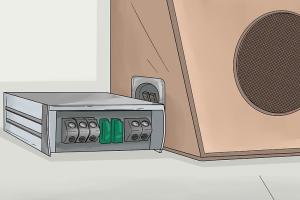Ultimate Guide: How to Install a Subwoofer in Your Car or Home Theater

-
Quick Links:
- 1. Introduction
- 2. Types of Subwoofers
- 3. Tools and Materials Needed
- 4. Step-by-Step Installation Guide
- 5. Tuning and Adjustments
- 6. Troubleshooting Common Issues
- 7. Case Studies and Examples
- 8. Expert Insights
- 9. FAQs
- 10. Conclusion
1. Introduction
Installing a subwoofer can significantly enhance your audio experience, whether in your car or home theater. With deep bass and improved sound quality, knowing how to properly install a subwoofer is essential for any audio enthusiast. This guide will walk you through the entire process, from understanding the types of subwoofers to troubleshooting common installation issues.
2. Types of Subwoofers
2.1 Passive Subwoofers
Passive subwoofers require an external amplifier to power them. They are typically less expensive and allow for more customization in your sound system.
2.2 Active (Powered) Subwoofers
Active subwoofers have a built-in amplifier, making them easier to set up. They are ideal for beginners or those who want a quick installation process.
2.3 Home Theater vs. Car Audio Subwoofers
Understanding the differences between home theater and car audio subwoofers is crucial. Home theater subwoofers are usually designed for low frequencies and can be larger, while car subwoofers are often compact and built for the acoustic environment of a vehicle.
3. Tools and Materials Needed
Before you start your installation, gather the following tools and materials:
- Subwoofer (passive or active)
- Amplifier (if installing a passive subwoofer)
- Speaker wire
- Power wire
- Fuse holder and fuse
- RCA cables
- Wire strippers
- Screwdriver set
- Drill (if necessary)
- Multimeter
- Heat shrink tubing or electrical tape
4. Step-by-Step Installation Guide
4.1 Installing a Subwoofer in Your Car
Follow these steps to install a subwoofer in your car:
- Choose the Location: Decide where you want to place your subwoofer. Common spots include the trunk or under a seat.
- Disconnect the Battery: Before starting, disconnect your car battery to prevent any electrical issues.
- Run the Power Wire: Use the drill to create a hole for the power wire from the battery to the subwoofer location. Ensure the wire is well insulated.
- Connect the Amplifier: If using a passive subwoofer, connect the amplifier to the subwoofer. Use the speaker wire to connect the amplifier to the subwoofer terminals.
- Connect RCA Cables: Run RCA cables from the head unit to the amplifier, ensuring they are kept away from power wires to avoid interference.
- Reconnect the Battery: Once all connections are secure, reconnect the battery and test the system.
4.2 Installing a Subwoofer in Your Home Theater
The installation process for a home theater subwoofer is slightly different:
- Choose the Location: Ideal locations are corners or away from walls to enhance sound quality.
- Connect to AV Receiver: If using a powered subwoofer, connect it to the AV receiver via the LFE (Low-Frequency Effects) output.
- Calibrate the Subwoofer: Use your receiver’s calibration feature to optimize the sound settings for your room.
5. Tuning and Adjustments
Tuning your subwoofer is critical for achieving the best sound quality. Adjust the gain, low-pass filter, and phase settings on the amplifier or subwoofer to suit your listening preferences.
6. Troubleshooting Common Issues
If you encounter issues with your installation, consider the following:
- No Sound: Check all connections and ensure your amplifier is powered.
- Distorted Sound: Lower the gain or check the wiring for shorts.
- Subwoofer Not Turning On: Verify the fuse and power connections.
7. Case Studies and Examples
Analyze real-world examples of successful subwoofer installations. For instance, a local car audio shop reported a 30% increase in customer satisfaction after providing personalized installation tutorials.
8. Expert Insights
Industry experts recommend investing in quality components to avoid common pitfalls in installation. They also suggest testing your setup in various conditions to ensure optimal performance.
9. FAQs
1. Can I install a subwoofer myself?
Yes, with the right tools and this guide, you can successfully install a subwoofer.
2. Do I need an amplifier for a powered subwoofer?
No, powered subwoofers have built-in amplifiers.
3. How do I know which subwoofer to choose?
Consider your audio needs, space constraints, and whether you want a passive or active subwoofer.
4. What is the best location for a subwoofer?
In a car, the trunk is usually best; in a home, corners often provide better bass response.
5. Can I use a subwoofer with any audio system?
Most systems can accommodate a subwoofer, but compatibility depends on the output options available.
6. How long does the installation take?
Installation can take anywhere from 1 to 3 hours, depending on your experience and system complexity.
7. What tools do I need for installation?
You will need basic tools like screwdrivers, wire strippers, and possibly a drill.
8. What if my subwoofer is not working after installation?
Check all connections, power supply, and settings to troubleshoot the issue.
9. Is it better to hire a professional?
If you are uncomfortable with electrical work, hiring a professional is a good choice.
10. Can I install multiple subwoofers?
Yes, you can install multiple subwoofers, but ensure your amplifier can handle the load.
10. Conclusion
Installing a subwoofer can be a rewarding project that enhances your audio experience. With careful planning, appropriate tools, and following this comprehensive guide, you can enjoy deep, rich sound that brings your music and movies to life.